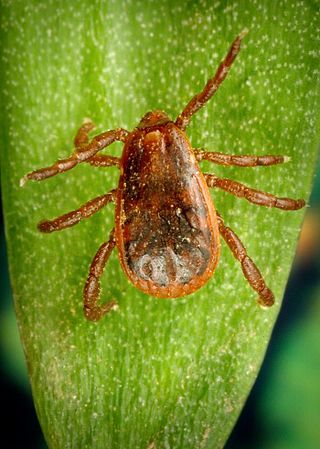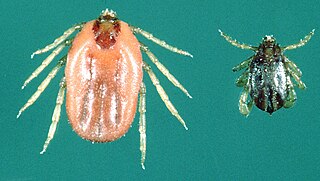
Kyasanur forest disease (KFD) is a tick-borne viral haemorrhagic fever endemic to South-western part of India. The disease is caused by a virus belonging to the family Flaviviridae. KFDV is transmitted to humans through the bite of infected hard ticks which act as a reservoir of KFDV.

Rhipicephalus sanguineus, commonly called the brown dog tick, kennel tick, or pantropical dog tick, is a species of tick found worldwide, but more commonly in warmer climates. This species is unusual among ticks in that its entire lifecycle can be completed indoors. The brown dog tick is easily recognized by its reddish-brown color, elongated body shape, and hexagonal basis capituli. Adults are 2.28 to 3.18 mm in length and 1.11 to 1.68 mm in width. They do not have ornamentation on their backs.

Rhipicephalus is a genus of ticks in the family Ixodidae, the hard ticks, consisting of about 74 or 75 species. Most are native to tropical Africa.

The Asian blue tick is an economically important tick that parasitises a variety of livestock species especially cattle, on which it is the most economically significant ectoparasite in the world. It is known as the Australian cattle tick, southern cattle tick, Cuban tick, Madagascar blue tick, and Puerto Rican Texas fever tick.
Amblyomma javanense is a hard-bodied tick of the genus Amblyomma. It is found in Vietnam, Indonesia, Malaysia, India, Sri Lanka, Philippines and Thailand. It is the only ectoparasite found on the Manis javanica, Manis crassicaudata and also from Sus scrofa.
The Asian monitor lizard tick, is a hard-bodied tick of the genus Amblyomma. It is found in India, Thailand, Taiwan and Sri Lanka. Adults parasitize various reptiles such as varanids and snakes. These ticks are potential vectors of spotted fever group (SFG) rickettsiae.
Ixodes petauristae is a hard-bodied tick of the genus Ixodes. It is found in India and Sri Lanka. Adults parasitize various smaller mammals such as Ratufa indica, Funambulus tristriatus, Macaca radiata, Petaurista sp. and mice. It is a potential vector of Kyasanur Forest disease virus,
Ixodes ceylonensis is a hard-bodied tick of the genus Ixodes. It is found in India and Sri Lanka. It is an obligate ectoparasite of mammals.
Haemaphysalis bispinosa is a hard-bodied tick of the genus Haemaphysalis. It is found in India, Sri Lanka, Myanmar, Pakistan, Nepal, Australia, and Indonesia. It is an obligate ectoparasite of mammals. It is a potential vector of Kyasanur Forest disease virus. These ticks was found parasitized by a chalcid Hunterellus sagarensis in these diseased areas.
Haemaphysalis anomala is a hard-bodied tick of the family Ixodidae. It is found in India, Vietnam and Sri Lanka. It is an obligate ectoparasite of mammals.
Haemaphysalis cuspidata is a hard-bodied tick of the genus Haemaphysalis. It is found in India and Sri Lanka. It is a potential vector of Kyasanur Forest disease virus.
Haemaphysalis hystricis, the East Asian mountain haemaphysalid, is a hard-bodied tick of the genus Haemaphysalis. It is found in India, Sri Lanka, Vietnam, Myanmar, China, Japan, India, Indonesia, Laos, Taiwan and Thailand. It is an obligate ectoparasite of mammals. It is a potential vector of Kyasanur Forest disease virus, Coxiella sp., Ehrlichia sp., and Rickettsia japonica. In 2007, an unknown trypanosoma species known as Trypanosoma KG1 isolate was isolated from naturally infected H. hystricis ticks.
Haemaphysalis intermedia, the flat-inner-spurred haemaphysalid, is a hard-bodied tick of the genus Haemaphysalis. It is found in India and Sri Lanka. It is an obligate ectoparasite of mammals. It is a potential vector of Kyasanur Forest disease virus, Ganjam virus, and Nairobi sheep disease virus.
Haemaphysalis minuta, is a hard-bodied tick of the genus Haemaphysalis. It is found in India and Sri Lanka. It is an obligate ectoparasite of mammals. It is a potential vector of Kyasanur Forest disease virus.
Haemaphysalis spinigera, is a hard-bodied tick of the genus Haemaphysalis. It is found in India, Sri Lanka, Vietnam. It is an obligate ectoparasite of mammals of various rodents, insectivores and monkeys. It is a potential vector of Kyasanur Forest disease virus, and Kaisodi virus.
Haemaphysalis turturis is a hard-bodied tick of the family Ixodidae. It is found in India and Sri Lanka. It is an obligate ectoparasite of mammals. It is a potential vector of Kyasanur Forest disease virus, and ganjam virus.
Hyalomma brevipunctata, or Sharif's Indian hyalomma, is a hard-bodied tick of the family Ixodidae. It is found in India and Sri Lanka.
Nosomma monstrosum, is a hard-bodied tick of the genus Nosomma. It is found in India, Bangladesh, Sri Lanka and Vietnam.

The cattle tick,, is a hard-bodied tick of the genus Rhipicephalus. It is also known as North American cattle tick, North American Texas fever tick, and Texas fever tick.





